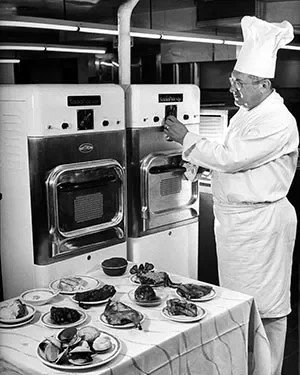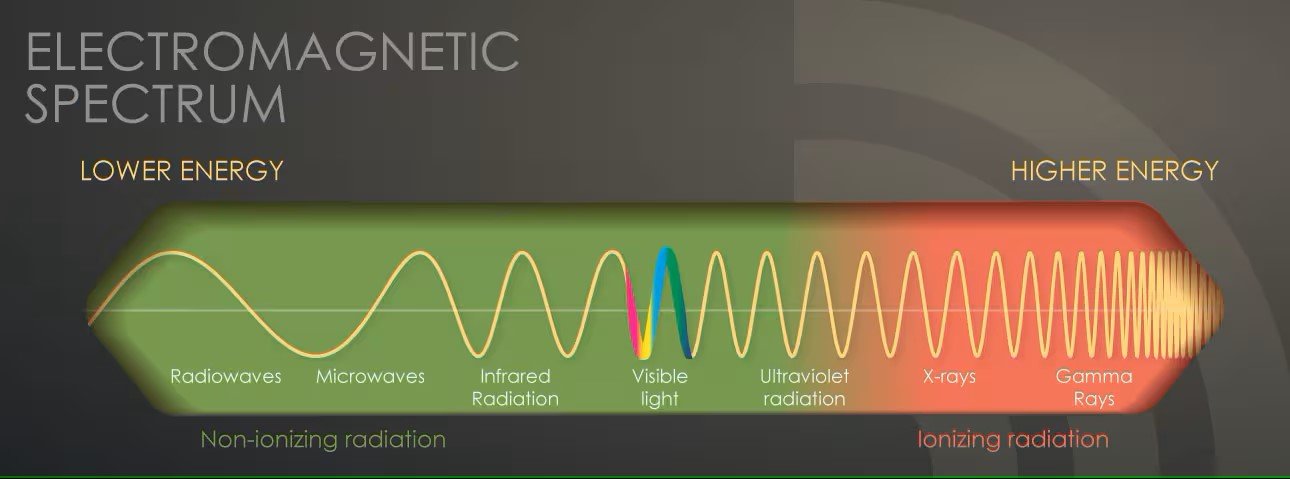How do microwave ovens work?
The microwave oven is found in over 90% of households in the United States of America today, making it one of the most widely distributed electronic appliances in the county. But how do they work? And where did we get the idea to use radiation to reheat leftovers and pop popcorn?
Image: 1946 Raytheon Radarange
The Origins of the Microwave Oven
The conception of the microwave oven is directly connected to the technology behind radar. An integral component of the advanced radar systems used by Allied Forces during WWII was the cavity magnetron tube which used microwaves (electromagnetic waves in the radio spectrum) to determine the location and distance of objects. Many cavity magnetron tubes were produced by Raytheon Manufacturing Company in Massachusetts, where a self-educated engineer named Percy LeBaron Spencer worked. Shortly after WWII, Spencer was working on a revised magnetron unit when he made an interesting observation: the candy bar in his pocket had melted. Spencer hypothesized that if the microwaves from the magnetron unit could heat the candy bar then they might be able to cook food.
Spencer tested his idea by placing popcorn kernels near the magnetron unit. And they popped! But finding an active radar system every time you want popcorn is just not practical. He had to find a way to localize and focus the microwaves for this purpose. In Spencer’s next experiment, he cut away a section of a metal kettle, placed a raw egg inside the kettle, and then directed the microwaves from the magnetron through the hole in the kettle. The egg exploded. But it cooked! Percy LeBaron Spencer inferred two points from these experiments: (1) microwaves can heat food enough to cook it, and (2) a metal box can be used to contain the microwaves.
Raytheon Manufacturing Company saw an incredible business opportunity, filed a patent, and the Radarange became available for purchase in 1946 for restaurants and airline companies. The Radarange was a boujie behemoth, standing at 6 feet tall and weighing 750 pounds with a retail price of $5,000. According to the Bureau of Labor Statistics, that’s over $58,000 in 2024! Understandably, most consumers were just not willing to spend that much money on a new type of technology. And its incredible size clashed with the space-saving kitchen design trend of the 1950s.
It would not be until 1967 that the first countertop microwave oven would become commercially available for homeowners. Amana, a company acquired by Raytheon, released the countertop Radarange for $495. Its compact design was more suitable to popular American kitchen designs and was much cheaper than the 1946 Radarange. But “cheaper” is relative. What was $495 in 1967 U.S. dollars would be over $4,700 in 2024. Fortunately for shoppers in 2024, the cost of a countertop microwave oven can range from $50 to $500.
What Happens While the Turntable Rotates?
Those who regularly use a countertop microwave oven are familiar with the same scene: you place your food on the turntable inside the microwave, set the desired time and intensity, press Start, a (usually) yellow light turns on, and you listen to the low hum as your food slowly rotates. The process between pressing Start and hearing the final beep is exactly the same as what happened when Percy LeBaron Spencer placed the egg in the metal kettle: microwave radiation is passed through your food at an intensity and duration needed to heat it.
Inside the microwave oven, a magnetron unit generates microwave radiation waves to send throughout the oven. Once generated, the microwaves bounce around the metal interior of the oven. The metal body of the microwave oven prevents the microwave radiation from escaping. The microwaves are then absorbed into the water, sugar, and fat molecules within the food being heated. Once absorbed, these molecules vibrate as they convert the absorbed microwave radiation into heat. This absorption and vibration within the molecules of the food is meant to ensure that the food cooks evenly. But microwave radiation can only travel so far, this is why the interior parts of thicker foods (like burritos or potatoes) can still be cold or raw in the center after microwaving.
Is your burrito still cold in the center after microwaving it? And does your leftover rice dry out after reheating? Here are a couple hacks: Cut your burrito in half before heating and cover your leftover rice with a wet microwave-safe paper towel during heating. This will give the emitted microwaves the best chance to reach deep inside your burrito and will prevent too many water molecules inside your food from evaporating.
Are Microwave Ovens Safe?
Image: the electromagnetic spectrum depicting ionizing radiation and non-ionizing radition
Microwaves are a non-ionizing type of electromagnetic radiation. The difference between ionizing radiation and non-ionizing radiation is how they interact with the atoms and molecules of a given object. Ionizing radiation—like x-rays and gamma rays to the right of ultraviolet radiation on the electromagnetic spectrum—remove electrons from atoms and molecules to form energy. Non-ionizing radiation—including ultraviolet radiation and everything else to the left on the electromagnetic spectrum—can “excite” the atoms and molecules of an object, causing them to vibrate without changing their structure.
Although we are exposed to non-ionizing radiation every day, moderation is key to ensuring we stay within safe levels of exposure. The metal body of a microwave oven reflects the microwave radiation, which mostly prevents it from leaking out and minimizes our exposure to non-ionizing microwave radiation. The manufacture, distribution, and use of microwave ovens in the United States has been regulated by the U.S. Food and Drug Administration (FDA) since 1971. A model of microwave oven is deemed safe for use if the amount of microwave radiation leaked during the entire lifetime of the product—meaning from the first time it is used to the time it eventually brakes down—is far below any amount that could cause harm to a person.
At this point, it is important to highlight a common misconception about microwave ovens, confusion about how microwave ovens effect nutritional value of food, and briefly mention a rare but deadly use of microwave ovens. First, a common misconception is that microwave ovens can cause cancer. Improper use of a microwave oven may result in superficial burns, but the American Oncology Institute states that there is no evidence showing that microwave radiation causes cancer. Second, there is some confusion about whether or not using microwave ovens to cook or heat food can reduce its nutritional value. Although the settings of a microwave oven can sometimes effect aspects of food, the effects to nutritional value of food heated in a microwave oven are not that different from using a conventional oven.
Lastly, there have been rare but deadly uses of microwave ovens resulting in the deaths of two infants in 2005 in Ohio and 2011 in California. This is not a true crime blog, so I will not go into great detail. But I will say that each case involved an adult placing an infant in a microwave oven for 2 minutes (in the 2005 Ohio case) and 5 minutes (in the 2011 California case), resulting in the deaths of both infants.
According to Whirlpool, the only things you should put into your microwave oven are foods, liquids, and microwave-safe containers like glass, ceramics, most paper towels, and some plastics. These microwave-safe materials allow microwave radiation to pass through them instead of absorbing them. Single-use plastics and some types of paper products coated in plastic are typically not microwave safe. Do not place metals, aluminum foil, Styrofoam, or cardboard in your microwave oven. Regardless of the container your food is in, it doesn’t hurt to stop and check if your container is microwave safe before heating it. And absolutely do not ever place a living human or animal within a microwave oven for any period of time ever.
Closing Thoughts
The invention of the microwave oven is tied to the use of advanced radar systems in World War II. A microwave oven uses a magnetron to produce microwave radiation, bouncing it around inside its metal casing, to heat the water, sugar, and fat molecules within food. Although it was absurdly expensive at the time of its initial release in 1946, the microwave oven has become one of the most affordable and widespread electronic appliances in the United States. There are misconceptions, confusions, and misuses of the microwave oven, but (if used as directed) it is one of the safest pieces of modern technology to use today.
Dångkulo' na' saina ma'åse'! Thank you so much for reading this Science in a Nutshell post!
Notes:
Random Thoughts posts are brief summaries of much larger topics.
Underlined text are hyperlinked to referenced sources.
Post Date: 12 September 2024


